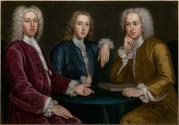Advanced Search
Daniel, Peter, and Andrew Oliver
John Smibert (American (born in Scotland), 1688–1751)
1732
Medium/Technique
Oil on canvas
Dimensions
99.69 x 144.46 cm (39 1/4 x 56 7/8 in.)
Credit Line
Emily L. Ainsley Fund
Accession Number53.952
CollectionsAmericas
ClassificationsPaintings
By the 1720s, Boston, a thriving port whose population had more than doubled in the preceding two decades, was in need of an able portrait painter to commemorate members of its wealthiest families. In 1729 the forty-year-old Scottish artist John Smibert arrived in the city. Having trained and worked successfully in London and spent three years in Italy, Smibert brought with him knowledge of the latest British and Continental styles. He rapidly attracted an eager following, and his work was in great demand. Patrons traveled from as far away as Newport and Albany to sit for him, and he became the first colonial portraitist able to make a living from commissions in one city for several years, although he did also sell artists’ supplies in his “color shop” in Boston to supplement his income. In 1740 Smibert traveled to New York; Philadelphia; and Burlington, New Jersey, where prosperous patrons also commissioned portraits. Smibert’s cosmopolitan background and his marriage in 1730 to the daughter of a physician and schoolteacher elevated his own social status and raised the standing of artists in the colonies.
The Olivers were among Smibert’s most faithful patrons, commissioning eleven portraits from him. Daniel, Peter, and Andrew Oliver was probably the second group portrait painted in the colonies. The first was Smibert’s masterpiece The Bermuda Group (1728–39, Yale University Art Gallery, New Haven, Connecticut), a portrait of Bishop George Berkeley (the man who encouraged Smibert to come to the colonies) and his family that served as a model for subsequent group portraits [1983.34]. In the Oliver painting, as in The Bermuda Group, the figures are arranged around a table, are placed close to the picture plane, and fill up the entire canvas, giving the portrait a bold, sophisticated presence. Smibert’s ability to convey believable poses, individualized features, and the costly, yet unostentatious, clothing of his sitters far surpassed that of any previous colonial painter.
The sons of Daniel Oliver, a prosperous merchant and member of the Governor’s Council, and Elizabeth Belcher Oliver, sister of Governor Jonathan Belcher, Daniel, Peter, and Andrew all graduated from Harvard. In addition to the challenge of depicting the three brothers on one canvas, Smibert also had to borrow the image of the eldest son, Daniel (who had died of smallpox five years earlier in London), from a 1727 miniature painted by an unidentified English artist. Although Smibert depicted Daniel, on the left, in a rather wooden manner, typical of a posthumous likeness, he succeeded in capturing the personalities of the other two brothers. The youngest son, Peter, in the center, confronts the viewer with an air of confidence and worldly sophistication. Andrew, reportedly a serious student during his Harvard days, is portrayed on the right in a contemplative pose, his hand to his head, his elbow resting on a book.
This text was adapted from Elliot Bostwick Davis, et al., American Painting [http://www.mfashop.com/9020398034.html], MFA Highlights (Boston: MFA Publications, 2003).
The Olivers were among Smibert’s most faithful patrons, commissioning eleven portraits from him. Daniel, Peter, and Andrew Oliver was probably the second group portrait painted in the colonies. The first was Smibert’s masterpiece The Bermuda Group (1728–39, Yale University Art Gallery, New Haven, Connecticut), a portrait of Bishop George Berkeley (the man who encouraged Smibert to come to the colonies) and his family that served as a model for subsequent group portraits [1983.34]. In the Oliver painting, as in The Bermuda Group, the figures are arranged around a table, are placed close to the picture plane, and fill up the entire canvas, giving the portrait a bold, sophisticated presence. Smibert’s ability to convey believable poses, individualized features, and the costly, yet unostentatious, clothing of his sitters far surpassed that of any previous colonial painter.
The sons of Daniel Oliver, a prosperous merchant and member of the Governor’s Council, and Elizabeth Belcher Oliver, sister of Governor Jonathan Belcher, Daniel, Peter, and Andrew all graduated from Harvard. In addition to the challenge of depicting the three brothers on one canvas, Smibert also had to borrow the image of the eldest son, Daniel (who had died of smallpox five years earlier in London), from a 1727 miniature painted by an unidentified English artist. Although Smibert depicted Daniel, on the left, in a rather wooden manner, typical of a posthumous likeness, he succeeded in capturing the personalities of the other two brothers. The youngest son, Peter, in the center, confronts the viewer with an air of confidence and worldly sophistication. Andrew, reportedly a serious student during his Harvard days, is portrayed on the right in a contemplative pose, his hand to his head, his elbow resting on a book.
This text was adapted from Elliot Bostwick Davis, et al., American Painting [http://www.mfashop.com/9020398034.html], MFA Highlights (Boston: MFA Publications, 2003).
Provenance1732, Andrew Oliver, Boston (sitter on the right); 1774, by inheritance to Andrew Oliver, his son, Boston; by descent within the family to Dr. Fitch Edward Oliver, Boston; by 1930 by inheritance to Dr. Andrew Oliver, Dr. Edward P. Oliver, E. Lawrence Oliver, and Susan L. Oliver, his children, Boston; 1953, purchased by the MFA for $10,000. (Accession Date: June 16, 1953)





